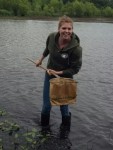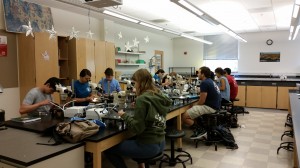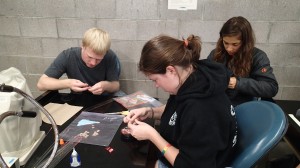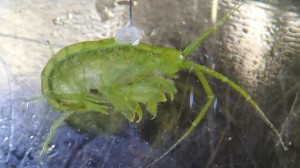A test worth taking
by Ellie Marin (UC Davis undergraduate, ZENtern)
Exams are inherently nerve-wracking. First there’s the main concern – did I study enough? Did I study the right material? And then there are other details – I have nightmares about running out of ink in my pen, accidentally missing questions on the back side of an exam
page, or even forgetting to write my name on the top of the exam paper. But, one thing I’d never feared was being stalled by accidently super gluing my hand to the exam paper itself. If there’s one thing I’ve learned from the Seagrass Ecosystem Ecology course taught by Drs. Pamela Reynolds and Jay Stachowicz that I’m taking at UC Davis, it’s to be prepared for the unexpected.
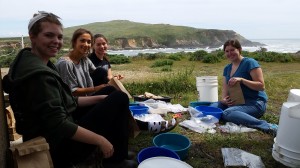
Ellie (left) and classmates conduct research at UC Davis’ Bodega Marine Laboratory for the ZEN undergraduate course in Seagrass Ecosystem Ecology
This hands-on field methods course was designed to educate the undergraduate students participating in the ZEN research (the “ZENterns”) on the methodology, theory, history, and purpose behind seagrass ecology and the Zostera Experimental Network. Our class featured a weekend trip to Bodega Bay, California to conduct field research, student presentations of papers from the primary literature, lectures, and group research activities. Today’s lab practical exam was intended to assess how much we learned from all of the different aspects of the course. In preparation for the exam, I read through my notes. It is a fairly hands-on class, so I wasn’t exactly sure how to study. Chatting with my 11 classmates revealed that we were all in the same boat.

UCD ZEN students perform the class practical exam, which involved answering questions on the course subject matter as well as demonstrating skills developed during the course.
Similar to other laboratory courses, our class practical featured a written portion as well as directed questions from a series of different stations setup around the laboratory. After a timed 30 minutes to complete the 5 pages of short answer questions, I started on the first lab station and the clock ticked down for us to rotate every 5 minutes. Some stations had microscopes with animals under them for us to identify and others materials for us to perform targeted lab skills. I glanced upon the familiar mesograzers under the scope, stumbled through some exotic amphipod identification, measured eelgrass shoots, and even wrote a haiku about epiphytes. The 5 minute periods per station rushed and rushed. I scribbled until the last second. And then I got to one station that fortunately, didn’t involve writing. Yes! Something I’ve done before! “Tether an isopod. Next, tether an amphipod.” We’d done this during our field trip at Bodega Bay to assess predation rates on mesograzers in the field. I got out the glue, set the line, caught the mesograzer. I was all set. No tricks. No doubts. I just had to tether the little guys. But this time it was different.
When we tethered the animals on the field trip, our instructors did not time us. This time I was racing against the clock. I quickly trimmed 20 cm of fishing line for the tether and began tying the proper knots to secure it. It wasn’t this difficult before! This line seems different! The sweat on my hands is not helping! After finally succeeding in tying an appropriate knot, I trimmed the line down and began looking for my first bug. I spotted one and bypass the forceps to plunge my hand into their housing container. I gently grab an isopod and place him on a paper towel to dry off. He’s sedentary. Good news. I grab the glue and squeeze a blob on the knot in my line. The next part is tricky. I have to glue his line – his crustacean leash – right onto his back. Success! After getting it to stick, I put the little guy into a water cup and watch him swim around with his little line in tow.
I’m half done now! I next set my sights on the amphipod. In the heat of the exam, I forget the order of the tethering process and plunge my hand into the container to grab the only amphipod I see. It’s a lively gammarid who undulates all over the paper towel, nearly off the table. This isn’t right! I put him back in the water. Focus! I grab the line and begin to cut to 20 cm again. The knot tying frenzy begins. Just go slow. I make a proper knot and grab the glue. It’s not coming out! I squeeze the glue harder than usual until a thick blob encases my knot… it’ll do. I grab my lively amphipod and he begins twisting and spinning – he’s expected me this time. I use a dropper to drip water on him as he lays on the paper towel. This appears to have a calming effect, and he ceases his tantrum. Now the tricky part. The isopod was big, but this guy is small, just under 1 cm in length. I have to get the glue right on the middle of his back or I risk injuring him. I go for it and miss, somehow getting glue all over my fingers. My fingers start to stick together. I unstick them and attempt to refocus in order to finish out this station – I know I’m almost out of time.
I rearrange my station for better focus, and this involves moving my exam out of the way. Big mistake. I have glued my hand to my exam. I rip the paper off, revealing a thumb and palm covered in ripped, sticky white paper. The timer goes off and I put my amphipod that wouldn’t get tethered back for the next student. “Next Station.” The test continues with new, equally challenging tasks and I proceed, with the paper still glued to my hand
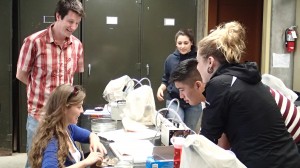
Drs. Pamela Reynolds and Jay Stachowicz (left) demonstrate amphipod tethering during the class field trip to the Bodega Marine Lab
The exam was hard. Not because I was underprepared – there are some things in life we can never prepare for. It was not unfair – I had either seen, performed, or learned everything on the exam. It’s not that there wasn’t enough time – everything in life has a time limit. The exam was hard because I have never had so much expected of me in a college class. Our instructors believe that we can do far more than simply answer A, B or C, or regurgitate a paragraph that we memorized from our notes. Our instructors dare us to reveal what we can actually contribute to science. They challenge us to be creative, resourceful, and clever. The point was to experience the exam, not just complete it. Success in research can be measured in how well we perform under stress. Things may not go as planned, but at the root of ecology is evolution, and we must all continue to adapt. This involves accepting our failures, building on our strengths, and focusing on how to move forward.
Some amphipods are meant to be free. Some tests are meant to be stressful. And some hands are meant to be glued.
Ellie is a rising senior at UC Davis pursuing her bachelor’s in biology. Her favorite aspect of the ZEN course was the exposure to field research, and her favorite experiment involved tethering amphipods to test for predation in the Bodega Bay seagrass beds. Her dream job is to be a science communicator and educator. She will be traveling to Ireland and Oregon to assist with ZEN research this summer with Drs. Nessa O’Connor and Fiona Tomas Nash, respectively.
Photos contributed by Aaron Goodman, Pamela Reynolds and Jay Stachowicz.

